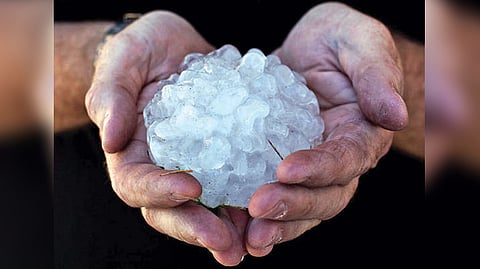

In August, a couple of days before his 68th birthday, Leslie Scott, a cattle rancher in Vivian, S.D., went to the post office, where he received some bad news. His world record had been broken, the clerk told him. That is, the hailstone Scott collected in 2010, which measured eight inches across and weighed nearly two pounds, was no longer the largest ever recorded. Some people in Canada had found a bigger one, the clerk said.
“I was sad all over the weekend,” Scott said, a few days after he heard the news. “I’ve been telling everybody that my record was broke.” Fortunately for Scott, this was not quite right. On Aug. 1, a team of scientists from Western University in London, Ontario, collected a giant hailstone while chasing a storm in Alberta, about 75 miles north of Calgary. The hailstone measured five inches across and weighed a little more than half a pound — half the size and one-quarter the heft of Scott’s. So it was not a world record, but a Canadian one.
The Canadian hailstone added to the list of regional records set in the past couple of years, including Alabama’s in 2018 (5.38 inches long, 0.612 pounds), Colorado’s in 2019 (4.83 inches, 0.53 pounds) and Africa’s in 2020 (around seven inches long, weight unknown). Australia set a national record in 2020, then set it again in 2021. Texas’ record was set in 2021. In 2018, a storm in Argentina produced stones so big that a new class of hail was introduced: gargantuan. Larger than a honeydew melon.
But the record-setting has come with increased hail damage. Although the frequency of reported “hail events” in the United States is at its lowest in a decade, according to a recent report by Verisk, a risk assessment firm, insurance claims on cars, houses and crops damaged by hail reached $16.5 billion in 2021 — the highest ever. Hail can strip plants to the stem and effectively total small cars. Ten years after the record-setting storm in Vivian, the tin roofs of some buildings are still dented. On Wednesday, a hailstorm killed a toddler in the Catalonia region of Spain.
“It’s one of the few weather hazards that we don’t necessarily build for,” said Ian Giammanco, a meteorologist at the Insurance Institute for Business & Home Safety. “And it’s getting bigger and worse.”
Although the changing climate probably plays a role in these trends, weather experts say, a more complete explanation might have something to do with the self-stoking interplay of human behavior and scientific discovery. As neighbourhoods sprawl into areas that experience heavy hail and greater hail damage, researchers have sought out large hailstones and documented their dimensions, stirring public interest and inviting further study.
Julian Brimelow, the director of the Northern Hail Project, a new collaboration among Canadian organisations to study hail, whose team found the record hailstone in August, said, “It’s a pretty exciting time to be doing hail research.”
The fixation with big hail goes back to at least the 1960s, when Soviet scientists claimed that they could significantly reduce the size of a storm’s hailstones by dispersing chemicals into the atmosphere. The method, called cloud seeding, promised to save millions of dollars in crop damage a year.
Visit news.dtnext.in to explore our interactive epaper!
Download the DT Next app for more exciting features!
Click here for iOS
Click here for Android